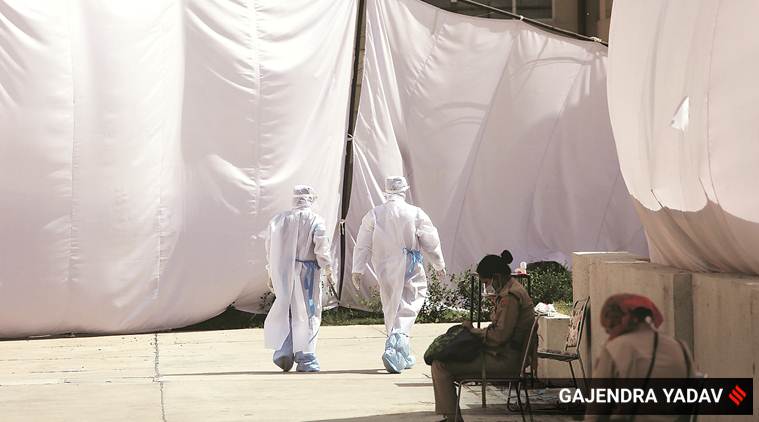 Quarantine facility in Narela. (Express photo by Gajendra Yadav)
Quarantine facility in Narela. (Express photo by Gajendra Yadav)
Announcements from loudspeakers never stop at the quarantine facility at Narela in outer Delhi.
Around 2 pm, members of the Tablighi Jamaat step out of their flats and form a line, as instructions boom from a loudspeaker. They are supposed to be screened for symptoms of the coronavirus — part of a daily routine at the facility.
Just last month, the 1,000-odd men quarantined at the facility had participated in a gathering at Markaz Nizamuddin, in what has now become an epicentre of the country’s coronavirus outbreak, with cases being reported across the country. More than 2,300 people were evacuated from the Markaz last month — those with symptoms were sent to hospitals, and others to quarantine facilities.
At the Narela facility, the men are known less by their names and more by their flat numbers.
During the daily screening, a nursing attendant announces flat numbers one by one. “Flat number 218,” the attendant says, and a man raises his hand and identifies himself.
The Army has accepted a request by authorities to handle medical screening at this facility, which has doctors, nursing attendants, maintenance staff and civil defence volunteers at the forefront.
“We have deputed around 20 officers, including doctors and nursing assistants. They are working along with civil and medical professionals as a part of the process of taking over screening duties. In the interest of smooth running of the facility, it is being ensured that the takeover process will be gradual,” Army sources told The Indian Express.
There are around 1,300 people under lockdown in three buildings. Two buildings house around 1,000 Tablighi Jamaat members, while the third houses people who came from abroad last month and were sent to quarantine from the airport.
One of them, a doctor from Roorkee, said, “Earlier, rooms were cleaned every day. Now there is a day’s gap. Thankfully my test was negative, I just have to find a way back home now.”
DDA vice-chairman Tarun Kapoor said that around 1,400 flats have been handed over to authorities to house the occupants. Each flat accommodates two people. Two beds, a table, a chair and a stool are provided in each house.
District Magistrate (North) Shinde Deepak Arjun said one patient has tested positive for coronavirus in the camp so far. In case anyone at the camp shows symptoms, one of four ambulances stationed there take the person to LNJP Hospital. The temperature of staff, too, is checked twice a day.
For sample collection, doctors at the camp are assisted by technical staff from B R Ambedkar and Sanjay Gandhi hospitals.
“We check for symptoms, and to maintain hygiene, we fumigate the premises daily. We also spray sodium chlorite solution around the camp. All possible measures are taken to keep everyone safe,” Arjun said.
The buildings follow a strict lockdown, with announcements making it clear that occupants cannot even stray into their balconies. The peripheral staff comprising sanitation workers, housekeeping staff and plumbers are the only ones who enter the building, dressed in personal protective equipment (PPE). Authorities said they have PPE kits to last them another two days, and new equipment is procured on a daily basis.
The day at the facility begins with sanitation workers cleaning the apartments. Outside one of the buildings, a sanitation worker dons his PPE kit. He is in charge of collecting waste and packing it into plastic bags of red and yellow, meant to be incinerated. “Every day as I enter these flats, I pray to god. And every time my temperature check comes normal, I thank god,” he says.
The doctors, meanwhile, break for lunch at the medical camp after a six-hour shift. “It is like working next to a nuclear meltdown site. The anxiety drains the energy from us. Otherwise we can work for 12 hours at a stretch. This is the hardest thing I have done so far,” says a doctor.